As atmospheric methane emissions continue to surge around the world, infrared absorption spectroscopy and advanced filters are providing actionable insights.
MARK NAPLES, UMICORE COATING SERVICES
In 2020, the world slammed to a halt. Flights were grounded. Cars remained parked in driveways. Smokestacks were extinguished, and industrial projects were put on hold as billions of people were confined to their homes. All the usual suspects of anthropogenic greenhouse gas emissions declined in output. Yet, while carbon dioxide emissions fell as expected, methane emissions surged.
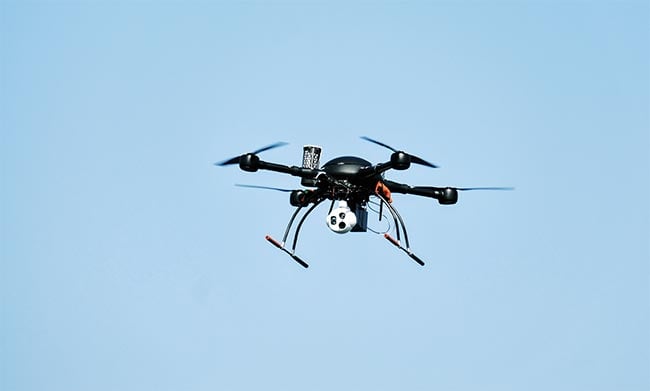
Small form-factor spectroscopy devices can be placed aboard drones and satellites for continuous monitoring of gas emissions. Courtesy of Umicore Coating Services.
Measurements of the air over South Sudan revealed methane levels jumped sharply during the year, starting from ~1860 ppb in late 2019 to peak at 1910 ppb by the end of 20201.
The news dealt a severe blow to humanity’s efforts to limit the advancement of global warming to 1.5 °C or below. Methane’s global warming potential is
up to 84× higher than that of carbon dioxide2. This is because methane’s
molecular structure can absorb more energy than carbon dioxide, and because methane forms other greenhouse gases
in the atmosphere, most notably in the
tropospheric ozone. It is also why, at 2021’s COP26 climate conference in Glasgow, Scotland, more than 100 countries adopted the Global Methane Pledge, which promised to reduce worldwide methane emissions by 30% by 2030,
relative to 2020 levels.
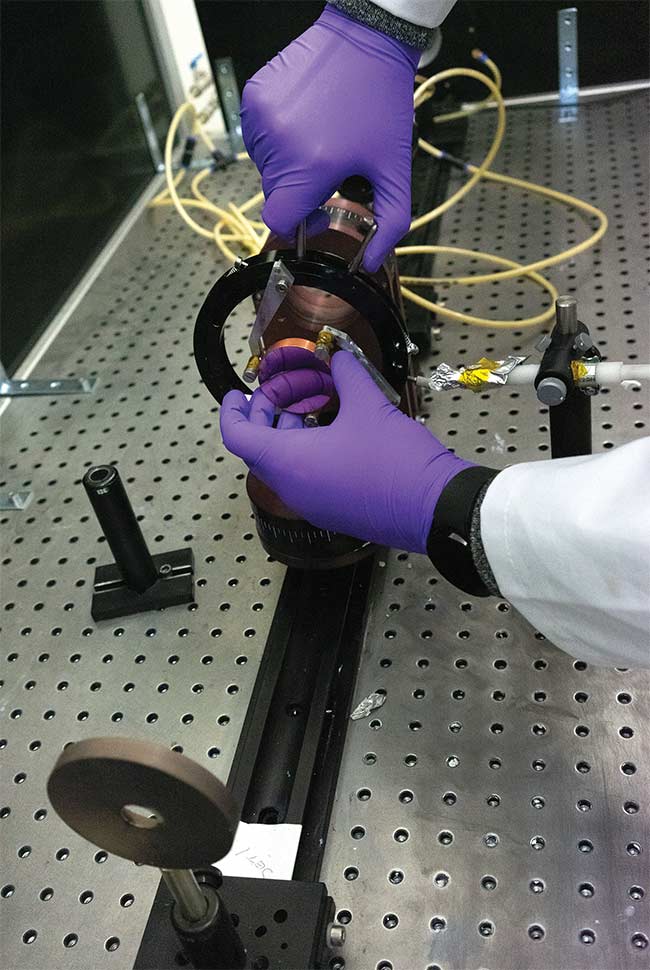
Highly specialized filters and coatings are at the core of IR absorption spectroscopy tools used in a wide range of gas sensing applications. Courtesy of Umicore Coating Services.
The scientific consensus generally agrees that exceeding this global heating target will lead to catastrophic climate tipping points, threatening the loss of glaciers and the Labrador Sea current; therefore this goal is vital to the future
of our planet. But how are we supposed
to deliver on the Global Methane
Pledge without solving mysteries such
as the 2020 methane surge? And how
are we supposed to develop this understanding without a solid foundation of accurate real-time data to inform our actions?
We cannot muddle our way to ending
global warming through guesswork. But, without the tools to gather data and expand our collective understanding of the different properties and effects that emissions have, then guesswork is all we have.
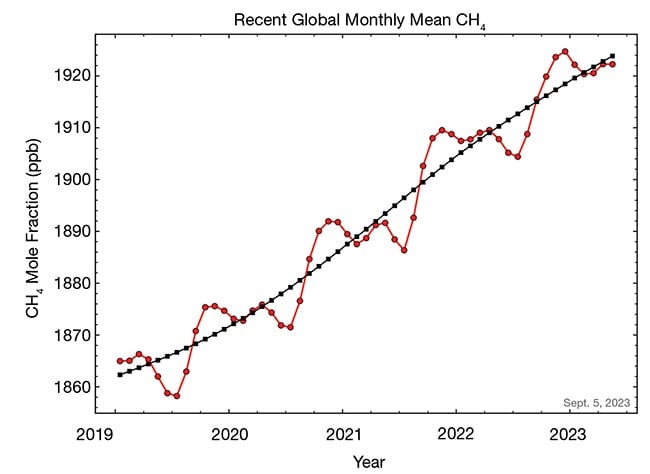
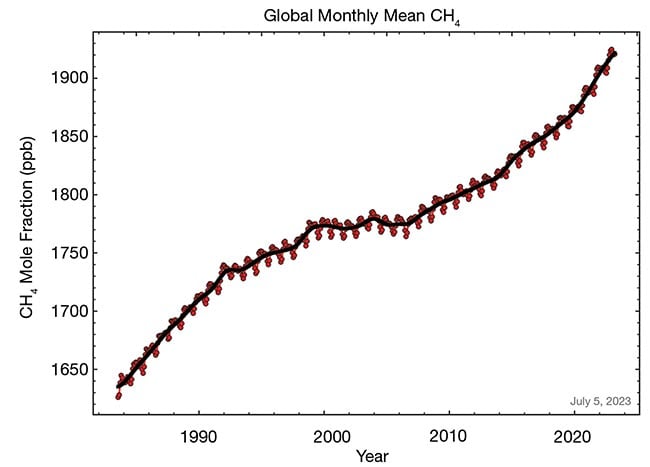
Globally averaged monthly mean atmospheric methane (CH4) abundance determined from marine surface sites. The monthly mean atmospheric methane abundance since 2019 (top). The full NOAA time-series showing atmospheric methane abundance starting in 1983 (bottom). Courtesy of Global Monitoring Laboratory.
Tools such as laser absorption spectroscopy are increasingly available and in use today, and more accessible and affordable than ever. Combined with sensor network architectures emerging under Industry 4.0, these tools can help paint a picture of a sustainable future by accurately describing the present.
Unraveling the methane mystery
The answers to the question of why methane emissions rose in 2020 are complex — so complex that they took researchers more than two years to figure out.
These answers paint a worrying picture. While anthropogenic methane emissions did fall as humankind consumed less gas, natural emissions rose sharply. Most of these emissions came from wetlands, where biomass is continually broken down by methane-producing algae. In fact, wetlands emissions rose by the highest amount since records began.
Following sustained warm, wet conditions across parts of the northern hemisphere — notably in Siberia — these methane-belching wetlands occupy more of the planet than ever before. As global warming thaws large chunks of polar
permafrost, large pockets of land are being gouged out by erosion, creating uneven, boggy terrain known as thermokarst. In other words, more wetlands equate with more biomass and algae, and more methane emissions.
Complicating matters is the complex interplay between the many unseen natural processes that take place in the natural world.
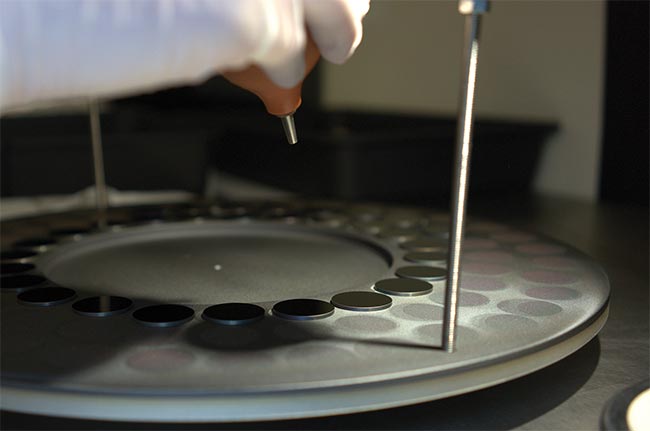
Production of coated lenses is now a refined, scalable process, making sensing technology more accessible than before. Courtesy of Umicore Coating Services.
Atmospheric methane can be broken down by hydroxyl radical molecules,
separating it into carbon dioxide and water. Though precise data on hydroxyl radicals is limited due to an active lifetime that lasts less than a second, they are one of many byproducts created when
fossil fuels are burned. Further, an increase in wildfires caused by hot, dry weather across the world is also thought to be driving a shortage of the “atmospheric detergent” hydroxyl radicals that react with carbon monoxide.
Solving the methane problem is no longer as simple as turning off the taps.
The right tools for the job
On a positive note, methane represents low-hanging fruit for detection and management. The International Energy Agency estimates that a third of human-related methane emissions come from oil and gas operations, representing the most obvious opportunity for engineers to develop solutions that can monitor emissions and inform actions when leaks occur. Such operations could limit the growth of biogenic emissions in the process.
Trillions of data points describing the location, concentration, and cause of methane emissions across the planet already exist, provided scientists have the necessary tools to collect them.
Recent methane monitoring studies have highlighted significant discrepancies between the measured quantities of natural gas released into the atmosphere and what is recorded in national inventories. Oil and gas infrastructure leaks account for alarming amounts of unreported methane emissions.
Given the number of natural emissions that heavy industry cannot control, it becomes even more important to do something about those that can be controlled.
If the future of the planet were not enough of a motivator, these emissions come at a cost. Between humanity and the Earth’s natural emissions, around $19 billion of natural gas is wasted every year. By employing a more rigorous approach to gas detection, supported by the right technologies, industrial operations can have a substantial effect on the future of the planet — and also on their own bottom lines.
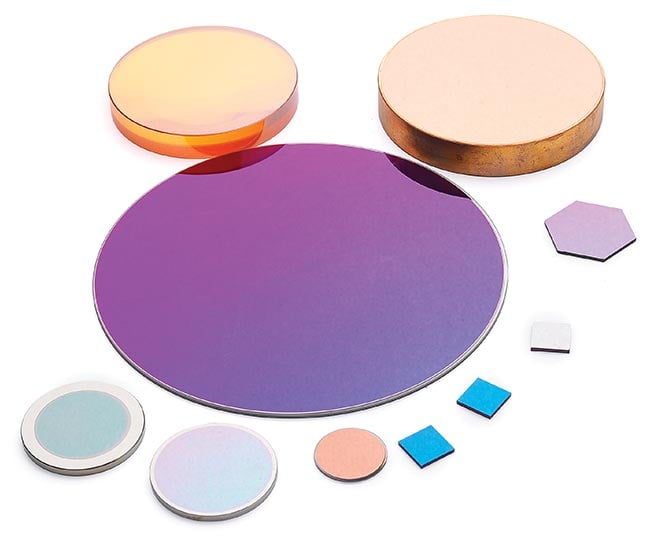
As advanced filters drive new spectrometer designs, advancements in coating technology have helped make laser absorption spectroscopy a highly scalable technology, as well as one that enables the development of more compact form factors. Courtesy of Umicore Coating Services.
With a data-driven, Industry 4.0 revolution underway in manufacturing and other industries, data sharing could enable businesses to establish a more clear, complete picture of their true environmental impact for the first time, provided that data is actually collected using appropriate sensing technology.
Laser absorption spectroscopy
Laser absorption spectroscopy is an analytical tool that provides information
based on how light is absorbed as it passes through a medium.
IR emitters within the instrument generate beams of light that pass through a sampling chamber with a filter inside it. This filters out all wavelengths but those absorbed by the particles of gas being monitored, so only those wavelengths can reach the detector. Different filters allow for the detection of different gases and distinct particles.
Newer gas analyzer instruments use a laser diode mounted on a thermo-electric cooler that can tune the laser’s wavelength to the specific absorption wavelength of a particular molecule. The diode sources exploit their high-frequency resolution, which enhances the instrument’s sensitivity, allowing it to register more significant levels of interaction between gas molecules and light in the order of parts per billion. It also heightens the tool’s ability to discriminate between specific gas compounds. This lowers the risk of false positives, which are a familiar issue for alternative gas detection technologies.
The sensors used in laser absorption spectroscopy deliver fast response times and accurate results and can operate in a vacuum, if necessary. Modern detectors
can now continuously monitor for combustible gases and vapors within the lower explosive limit and trigger alarm notifications if required. They allow deployment within oxygen-deficient or oxygen-enriched areas, require little calibration, and are immune to sensor poison, contamination, or corrosion.
The filter — and specifically how it is coated — is at the heart of laser absorption spectroscopy. The coating technology
plays a strong role in determining the suitability of a filter for a particular application. Advancements in coating technology are a large part of why laser absorption spectroscopy has become
a highly scalable technology, and one
enabling the development of more compact form factors.
Industrial gas detection is a mature market and continues to expand as analytical devices become cheaper at the compliance end of the market and smarter
at the top end.
Select filter suppliers are facilitating this evolution by working with OEMs to strip their spectrometer designs back to basics to focus on improving overall functionality while accommodating low-cost markets. At the same time, advanced filters are helping drive spectrometer designs that can yield new opportunities that allow end users to employ their devices in ways they have not considered before.
The methane challenge
Obscuring the effect of methane emissions is the fact that many businesses and national governments simply do not know how much methane they emit at all.
This is not always a matter of negligence. One inherent weakness of any IR-based sensing technology is that ambient water moisture can block IR wavelengths. This means that methane leaks in undersea pipelines or emissions in very humid areas can go undetected by monitoring satellites, which makes the global methane picture incomplete. However, increasingly cost-effective and small form factor IR sensing devices are helping to overcome this problem by enabling sensor deployment at a hyperlocal level.
Methane emissions often result from accidental gas leaks during fossil fuel production and transport, allowing them to escape unnoticed from oil and gas equipment or seep from long-abandoned old wells. Further, too little attention is given to curbing methane by plugging abandoned gas wells, sealing pipelines, covering up landfills, and preventing crop waste. Laser absorption spectroscopy could help remedy this if the technology is adopted on a regional, national, and international scale.
By embracing the data provided by these instruments, businesses can take more precise and informed actions in the fight against climate change. Industries, legislators, and consumers can all work together to help break the feedback loop of emissions that drive further emissions.
There are some methane emissions that humanity simply cannot control. Accepting this makes it all the more vital to drive down those we can control, particularly in the case of heavy industries that deal with hydrocarbons and natural gas. But to do that, we must first have the capacity to identify and understand where these emissions are, and how we can best cut them. Only then can we reckon with the vicious cycle of methane emissions — and finally break it once and for all.
Meet the author
Mark Naples is managing director at Umicore Coating Services. He has almost two decades of experience working across the optics,
sensing, and imaging industries; email: [email protected].
References
1. The European Space Agency (2022).
Methane levels surged in 2020 despite
lockdowns, www.esa.int/Applications/Observing_the_Earth/Copernicus/Sentinel-5P/Methane_levels_surged_in_2020_despite_lockdowns.
2. Table 8.7. G. Myhre et al. (2013). Chapter 8SM (Anthropogenic and Natural
Radiative Forcing) from AR5 Climate Change 2013. Intergovernmental Panel on Climate Change, www.ipcc.ch/site/assets/uploads/2018/02/WG1AR5_Chapter08_FINAL.pdf.